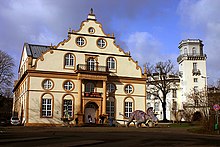Ottoneum
|
Museum logo |
|
| Data | |
|---|---|
| place | Kassel , Germany |
| Art | |
| architect | Wilhelm Vernukken |
| opening | 1888 |
| Number of visitors (annually) | 333.007 (2012) |
| operator |
City of Kassel
|
| management |
Kai Füldner
|
| Website | |
| ISIL | DE-MUS-073518 |
The Ottoneum in Kassel was the first permanent theater building in Germany and is now used as a natural history museum.
Building history
It was built under Landgrave Moritz from 1603 to 1606 by the architect Wilhelm Vernukken and named "Ottoneum" after Otto , the Landgrave's favorite son. With its trapezoidal shape, the floor area of the building is evidence of the first massive building that seeks to interpret the task of building a modern theater. The Ottoneum is located in the city center of Kassel, on Steinweg, in the immediate vicinity of Friedrichsplatz, right next to today's Kassel State Theater . The building was rebuilt from 1690 by the court architect Johann Conrad Giesler and served to store the landgraves' art and natural objects collection . A few years later the Kunsthaus was affiliated to the Collegium Carolinum founded by Landgrave Karl . The collegium was intended to complement the Latin schools and mainly taught natural sciences .
In 1888 natural history objects that were previously in the Museum Fridericianum came to the Ottoneum because there was no longer enough space in the Fridericianum.
On the night of October 22nd to 23rd, 1943, the building was badly damaged by incendiary and high-explosive bombs; many of the exhibits that had not previously been relocated were lost.
Natural history museum in the Ottoneum
history
As early as 1929, the city of Kassel had taken over the “Royal Prussian Natural History Museum”. After the destruction in World War II , the city rebuilt the museum and served as the natural history museum of the city of Kassel. In the years 1994–1997 the building was renovated and redesigned again. The more empty rooms were just after the renovation as additional exhibition space for the documenta X used.
Today there are permanent exhibitions on three floors on "Changes in the understanding of nature over the centuries", with some of the exhibits coming from the 400-year history of the collection. In addition, situations from the ancient times to the present are reproduced in "living space stagings" from the geographical area of today's North Hesse . There are also temporary exhibitions and special programs for children.
The most important exhibits include the 400-year-old Ratzenberger herbarium , which is considered the oldest systematically compiled herbarium in Europe, the world's first wooden library created by Carl Schildbach and the Goethe elephant , one of the oldest prepared large mammalian skeletons in a German natural history museum.
Directors (selection)
- Hermann Schulz (1951–1965)
- Curt Hartmann (1965-1970)
- Gerhard Follmann (1970–1982)
- Franz Malec (1984–2005, acting head from 1982 to 1984)
- Kai Füldner (since 2005)
literature
- Volker Helas: Monuments in Hessen - City of Kassel I. Theiss, Stuttgart 1984, ISBN 3-528-06232-0 .
- Alois Holtmeyer : The architectural and art monuments in the Kassel administrative region. VI. Volume: District of Cassel-Stadt. Part 2. Self-published by the state administration, Kassel 1923, pp. 517-523 ( digitized version ).
Web links
- Official website of the Natural History Museum in the Ottoneum
- Natural history museum in the Ottoneum . In: Kassel.de
Individual evidence
- ↑ Annual Report 2012. ( PDF (4.3 MB)) (No longer available online.) P. 40 , archived from the original on November 26, 2013 ; Retrieved May 9, 2013 .
Coordinates: 51 ° 18 ′ 48 ″ N , 9 ° 29 ′ 56 ″ E


